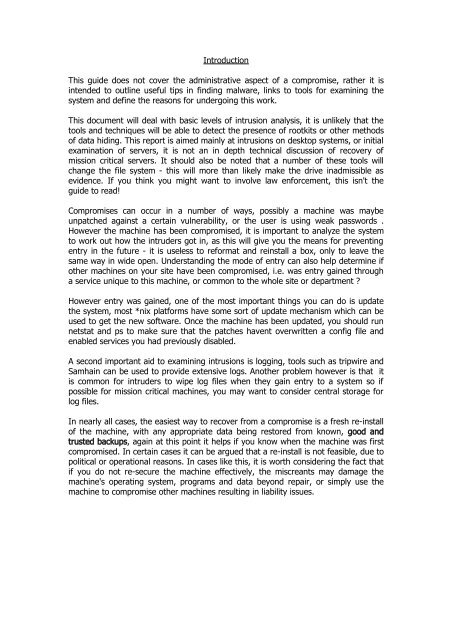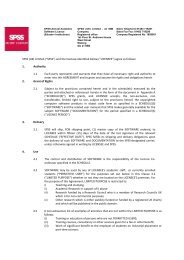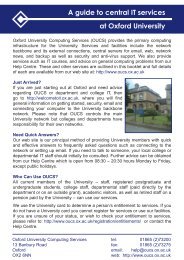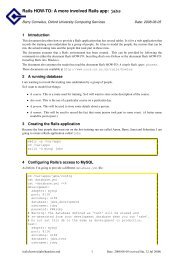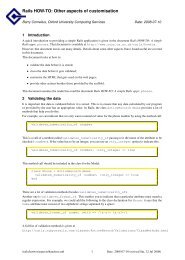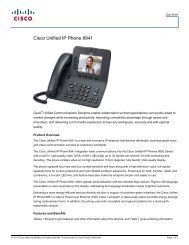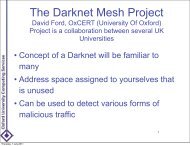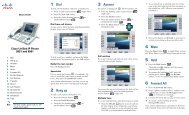Checking UNIX/LINUX Systems for Signs of Compromise - UCL
Checking UNIX/LINUX Systems for Signs of Compromise - UCL
Checking UNIX/LINUX Systems for Signs of Compromise - UCL
You also want an ePaper? Increase the reach of your titles
YUMPU automatically turns print PDFs into web optimized ePapers that Google loves.
Introduction<br />
This guide does not cover the administrative aspect <strong>of</strong> a compromise, rather it is<br />
intended to outline useful tips in finding malware, links to tools <strong>for</strong> examining the<br />
system and define the reasons <strong>for</strong> undergoing this work.<br />
This document will deal with basic levels <strong>of</strong> intrusion analysis, it is unlikely that the<br />
tools and techniques will be able to detect the presence <strong>of</strong> rootkits or other methods<br />
<strong>of</strong> data hiding. This report is aimed mainly at intrusions on desktop systems, or initial<br />
examination <strong>of</strong> servers, it is not an in depth technical discussion <strong>of</strong> recovery <strong>of</strong><br />
mission critical servers. It should also be noted that a number <strong>of</strong> these tools will<br />
change the file system - this will more than likely make the drive inadmissible as<br />
evidence. If you think you might want to involve law en<strong>for</strong>cement, this isn't the<br />
guide to read!<br />
<strong>Compromise</strong>s can occur in a number <strong>of</strong> ways, possibly a machine was maybe<br />
unpatched against a certain vulnerability, or the user is using weak passwords .<br />
However the machine has been compromised, it is important to analyze the system<br />
to work out how the intruders got in, as this will give you the means <strong>for</strong> preventing<br />
entry in the future - it is useless to re<strong>for</strong>mat and reinstall a box, only to leave the<br />
same way in wide open. Understanding the mode <strong>of</strong> entry can also help determine if<br />
other machines on your site have been compromised, i.e. was entry gained through<br />
a service unique to this machine, or common to the whole site or department ?<br />
However entry was gained, one <strong>of</strong> the most important things you can do is update<br />
the system, most *nix plat<strong>for</strong>ms have some sort <strong>of</strong> update mechanism which can be<br />
used to get the new s<strong>of</strong>tware. Once the machine has been updated, you should run<br />
netstat and ps to make sure that the patches havent overwritten a config file and<br />
enabled services you had previously disabled.<br />
A second important aid to examining intrusions is logging, tools such as tripwire and<br />
Samhain can be used to provide extensive logs. Another problem however is that it<br />
is common <strong>for</strong> intruders to wipe log files when they gain entry to a system so if<br />
possible <strong>for</strong> mission critical machines, you may want to consider central storage <strong>for</strong><br />
log files.<br />
In nearly all cases, the easiest way to recover from a compromise is a fresh re-install<br />
<strong>of</strong> the machine, with any appropriate data being restored from known, good and<br />
trusted backups, again at this point it helps if you know when the machine was first<br />
compromised. In certain cases it can be argued that a re-install is not feasible, due to<br />
political or operational reasons. In cases like this, it is worth considering the fact that<br />
if you do not re-secure the machine effectively, the miscreants may damage the<br />
machine's operating system, programs and data beyond repair, or simply use the<br />
machine to compromise other machines resulting in liability issues.


